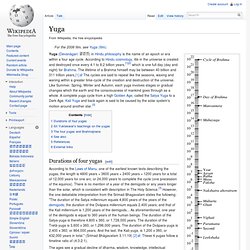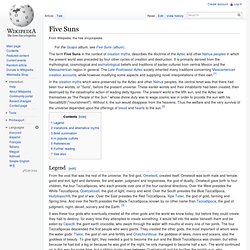

Yuga. Yuga (Devanāgari: युग) in Hindu philosophy is the name of an epoch or era within a four age cycle.

According to Hindu cosmology, life in the universe is created and destroyed once every 4.1 to 8.2 billion years,[1][2] which is one full day (day and night) for Brahma. The lifetime of a Brahma himself may be between 40 billion and 311 trillion years.[1] The cycles are said to repeat like the seasons, waxing and waning within a greater time-cycle of the creation and destruction of the universe. Like Summer, Spring, Winter and Autumn, each yuga involves stages or gradual changes which the earth and the consciousness of mankind goes through as a whole. A complete yuga cycle from a high Golden Age, called the Satya Yuga to a Dark Age, Kali Yuga and back again is said to be caused by the solar system's motion around another star.[3] Durations of four yugas[edit] The ages see a gradual decline of dharma, wisdom, knowledge, intellectual capability, life span, emotional and physical strength.
Brahma Kumaris World Spiritual University. The Brahma Kumaris World Spiritual University (BKWSU), or Prajapita Brahma Kumaris Ishwariya Vishwa Vidyalaya, sees itself as a vehicle for spiritual teaching and education in human and moral values[1] and often references its association with the United Nations as a non-governmental organization (NGO) in support of this view.

In the academic domain the BKWSU is usually considered a millenarian new religious movement (NRM) and is linked to the Hindu tradition due to its Indian origins. In interfaith dialogue the BKWSU is often considered a spiritual organisation rather than a religion. The Brahma Kumaris (Hindi: ब्रह्माकुमारी, literal translation "daughters of Brahma", abbreviated BK) was founded by Dada Lekhraj Kripalani, who later took the name Brahma Baba, in India in the 1930s.[2] It is distinctly identified by the prominent role women play in the movement.[3] While the leadership is primarily female, there is also a significant degree of participation from male members.[2] 1. 2. Five Suns. The term Five Suns in the context of creation myths, describes the doctrine of the Aztec and other Nahua peoples in which the present world was preceded by four other cycles of creation and destruction.

It is primarily derived from the mythological, cosmological and eschatological beliefs and traditions of earlier cultures from central Mexico and the Mesoamerican region in general. The Late Postclassic Aztec society inherited many traditions concerning Mesoamerican creation accounts, while however modifying some aspects and supplying novel interpretations of their own.[1] In the creation myths which were preserved by the Aztec and other Nahua peoples, the central tenet was that there had been four worlds, or "Suns", before the present universe. These earlier worlds and their inhabitants had been created, then destroyed by the catastrophic action of leading deity figures. Legend[edit] From the void that was the rest of the universe, the first god, Ometeotl, created itself. See also[edit] Six Ages of the World. The Six Ages of the World (Latin sex aetates mundi), also Seven Ages of the World (Latin septem aetates mundi), is a Christian historical periodization first written about by Saint Augustine circa 400 AD.[1] It is based upon Christian religious events, from the creation of Adam to the events of Revelation.

The six ages of history, with each age (Latin: aetas) lasting approximately 1,000 years, were widely believed and in use throughout the Middle Ages, and until the Enlightenment, the writing of history was mostly the filling out of all or some part of this outline. Six Ages[edit] The Six Ages as formulated by Saint Augustine, can be found in De catechizandis rudibus (On the catechizing of the uninstructed), Chapter 22: The Ages reflect the seven days of creation, of which the last day is the rest of Sabbath, illustrating the human journey to find eternal rest with God, a common Christian narrative. Theory[edit] The theory originated from a passage in II Peter: See also[edit] References[edit]